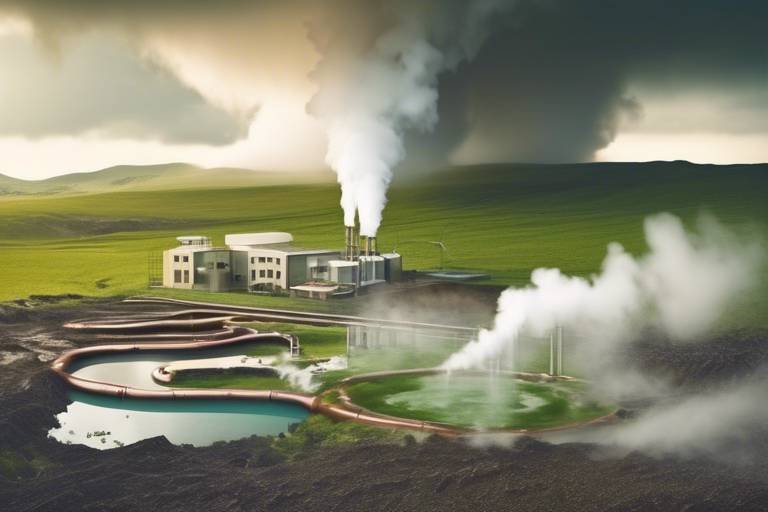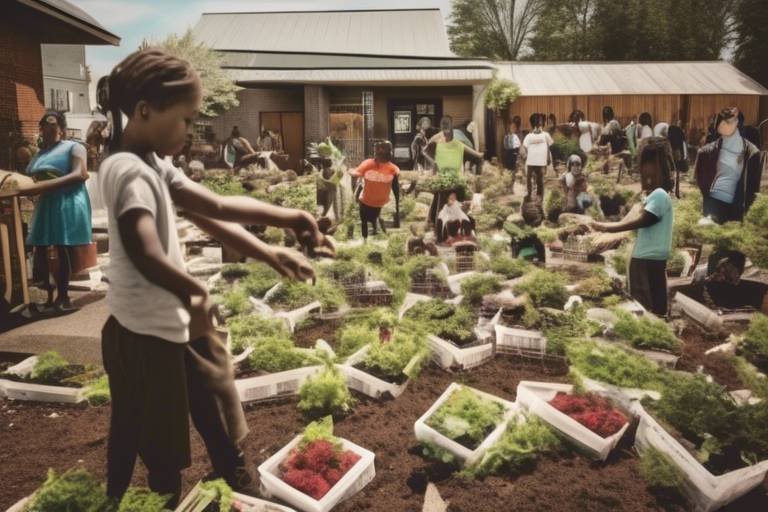Top 10 Eco-Friendly Fabrics For Your Wardrobe
This article explores sustainable fabric options that are kind to the planet and fashionable. Discover how these materials can transform your wardrobe while promoting environmental consciousness. In a world where fast fashion has taken the lead, it's time to pivot towards choices that not only enhance our style but also protect our planet. Choosing eco-friendly fabrics is like planting a seed for a greener future. Imagine wearing clothes that not only look good but also do good! By opting for sustainable materials, you're making a statement that resonates with the values of care and responsibility.
Organic cotton is a game-changer in the fabric world. Grown without harmful pesticides and fertilizers, it offers a safer choice for both the environment and farmers. This fabric is not just about being eco-friendly; it’s incredibly soft and breathable, making it a popular choice for everything from casual t-shirts to luxurious bed linens. Think about the comfort of slipping into a shirt made from organic cotton—it's like a gentle hug for your skin. Plus, the production process is less taxing on the planet, which means you can wear it with pride.
Next up is Tencel, a fabric that’s as smooth as silk and as sustainable as they come. Derived from sustainably sourced wood pulp, Tencel is known for its moisture-wicking properties, which means it keeps you cool and dry. It’s biodegradable, making it a fantastic alternative to conventional materials that often harm the environment. Imagine wearing a dress that feels like a soft breeze on a hot day—Tencel makes that possible while ensuring you’re treading lightly on the earth.
Hemp is often hailed as one of the most sustainable fabrics available. It requires minimal water and no pesticides to grow, making it a champion for sustainable agriculture. Not only is hemp incredibly durable, but it also has a natural resistance to mold, making it ideal for a variety of clothing and accessories. Think of hemp as the superhero of fabrics—strong, resilient, and eco-friendly. When you wear hemp, you’re not just making a fashion statement; you’re supporting a movement towards sustainable living.
Linen, made from flax plants, is another standout fabric on the eco-friendly roster. It’s biodegradable and uses significantly less water than cotton during its production. The breathable nature of linen makes it perfect for warm weather, while its timeless style ensures that it won’t go out of fashion. Picture yourself in a flowing linen dress on a sunny day, feeling the gentle breeze against your skin. That’s the beauty of linen—it’s stylish, comfortable, and kind to the environment.
Recycled polyester is a fabric that’s turning the waste of yesterday into the fashion of tomorrow. Made from post-consumer plastic bottles, it reduces waste and conserves resources, making it a versatile choice for activewear and everyday clothing. Imagine wearing a jacket made from recycled materials—every time you put it on, you’re helping to reduce plastic waste. It’s a win-win situation for both your wardrobe and the planet!
Bamboo fabric is derived from the fast-growing bamboo plant, which makes it a renewable resource. This fabric is not only soft and luxurious, but it also boasts natural antibacterial properties, making it a popular choice for sustainable clothing. Think of bamboo as the gentle giant of the fabric world—strong yet soft, and incredibly sustainable. Wearing bamboo fabric is like wrapping yourself in a cloud of comfort while knowing you’re making a positive impact.
Organic wool comes from sheep that are raised without synthetic chemicals, ensuring a more humane and environmentally friendly process. This warm, breathable fabric is perfect for cold-weather garments. Imagine cozying up in a soft wool sweater on a chilly evening, feeling snug and stylish. By choosing organic wool, you’re not just keeping warm; you’re supporting sustainable farming practices.
Piñatex is a revolutionary leather alternative made from pineapple leaf fibers. It’s sustainable, biodegradable, and cruelty-free, making it a stylish option for eco-conscious consumers. Think of Piñatex as the innovative cousin of leather—offering the same chic look without the environmental footprint. When you wear Piñatex, you’re making a bold statement about your values without sacrificing style.
Econyl is a regenerated nylon made from waste materials like fishing nets and fabric scraps. It offers the same quality as traditional nylon while promoting a circular economy and reducing ocean plastic. Picture wearing swimwear made from recycled materials, knowing that you’re helping to clean up our oceans. That’s the power of Econyl—it’s not just a fabric; it’s a movement towards a cleaner, more sustainable future.
Q: Why should I choose eco-friendly fabrics?
A: Eco-friendly fabrics reduce environmental impact, promote sustainable practices, and often provide better quality and comfort.
Q: Are eco-friendly fabrics more expensive?
A: While some eco-friendly fabrics may have a higher upfront cost, they often last longer and are made from sustainable materials, making them a worthwhile investment.
Q: How can I identify eco-friendly fabrics?
A: Look for certifications like GOTS (Global Organic Textile Standard), OEKO-TEX, and check for materials such as organic cotton, Tencel, or recycled fabrics.

1. Organic Cotton
This article explores sustainable fabric options that are kind to the planet and fashionable. Discover how these materials can transform your wardrobe while promoting environmental consciousness.
Organic cotton is not just a buzzword; it's a revolution in the textile industry! Unlike conventional cotton, which is often grown with harmful pesticides and fertilizers, organic cotton is cultivated using natural farming methods that prioritize the health of the soil and the surrounding ecosystem. This means that every time you wear a piece made from organic cotton, you're not just wearing a soft, breathable fabric; you're also making a choice that supports sustainable agriculture and the well-being of farmers.
Imagine wrapping yourself in a fabric that’s as gentle on your skin as it is on the planet. Organic cotton is known for its incredible softness, making it a favorite for everything from t-shirts to bed linens. Plus, it’s breathable, which means it keeps you comfortable in both warm and cool weather. Think of it as the fabric equivalent of your favorite cozy blanket—perfect for snuggling up or stepping out in style!
Here are some key benefits of organic cotton:
- Environmental Impact: Organic cotton farming uses 88% less water than conventional methods, which is a significant reduction in a world where water scarcity is becoming a pressing issue.
- Healthier for Farmers: By avoiding toxic chemicals, organic cotton farming protects the health of farmers and their families, creating a safer working environment.
- Durability: Despite its softness, organic cotton is incredibly durable, meaning your clothes will last longer and reduce the need for frequent replacements.
Moreover, organic cotton is versatile. It can be blended with other sustainable materials to create unique fabrics that enhance both performance and style. For instance, when combined with hemp or Tencel, it results in fabrics that are not only eco-friendly but also have enhanced durability and comfort.
As consumers become more conscious of their purchasing decisions, the demand for organic cotton is on the rise. This shift is encouraging more farmers to transition to organic practices, further promoting sustainability in the fashion industry. So, next time you're shopping for clothing, look for the GOTS (Global Organic Textile Standard) certification label, which ensures that the cotton is truly organic and meets high environmental and social criteria.
Choosing organic cotton is not just about fashion; it’s about making a statement. It’s about saying “yes” to a healthier planet and “no” to harmful chemicals. By incorporating organic cotton into your wardrobe, you’re not only enhancing your style but also contributing to a more sustainable future. So, why not embrace this eco-friendly fabric and wear your values proudly?
Q: What makes organic cotton different from regular cotton?
A: Organic cotton is grown without synthetic pesticides and fertilizers, focusing on natural farming practices that are better for the environment and the health of farmers.
Q: Is organic cotton more expensive?
A: While organic cotton can be slightly more expensive due to its sustainable farming practices, the long-term benefits for the environment and your health make it a worthwhile investment.
Q: How can I tell if a cotton product is organic?
A: Look for certifications like GOTS or OEKO-TEX, which ensure that the cotton has been grown and processed according to strict organic standards.

2. Tencel (Lyocell)
Tencel, also known as Lyocell, is a fabric that has gained immense popularity in the sustainable fashion world. Derived from sustainably sourced wood pulp, Tencel is not just a fabric; it’s a statement. Imagine wearing something that feels as soft as a cloud against your skin while also being kind to the planet. This biodegradable fabric is produced in a closed-loop process, which means that the solvents used in its production are recycled and reused, minimizing waste. Isn't that amazing?
What sets Tencel apart from other fabrics is its moisture-wicking properties. This means it can absorb moisture away from your body, keeping you dry and comfortable throughout the day. Whether you're out for a jog or just lounging at home, Tencel ensures you feel fresh. Plus, it’s naturally breathable, making it a fantastic choice for warmer climates. Picture yourself on a sunny day, wearing a flowy Tencel dress that moves with you—sounds dreamy, doesn’t it?
Another great aspect of Tencel is its versatility. It can be blended with other fibers, such as cotton or linen, to enhance its qualities. This adaptability allows designers to create a wide range of clothing items, from luxurious shirts to comfortable activewear. And let’s not forget about its environmental impact. By choosing Tencel, you’re not only elevating your wardrobe but also supporting sustainable practices that help reduce deforestation and pollution.
If you’re curious about how Tencel compares to other fabrics, here’s a quick comparison table that highlights some key features:
| Fabric | Source | Biodegradable | Moisture-Wicking | Softness |
|---|---|---|---|---|
| Tencel (Lyocell) | Wood Pulp | Yes | Excellent | Very Soft |
| Cotton | Cotton Plant | Yes | Good | Soft |
| Polyester | Petroleum | No | Fair | Varies |
In conclusion, Tencel (Lyocell) is more than just a fabric; it’s a movement towards sustainability in fashion. Whether you're dressing up for a special occasion or just looking for something comfy to wear at home, Tencel offers a blend of comfort, style, and eco-friendliness. So, the next time you’re shopping for clothes, why not consider embracing this wonderful fabric? Your wardrobe—and the planet—will thank you!

3. Hemp
When it comes to sustainable fabrics, hemp truly stands out as one of the most eco-friendly options available. This remarkable plant thrives in a variety of climates and requires minimal water compared to conventional crops. In fact, hemp can grow in poor soil conditions, which means it doesn't deplete the earth's nutrients as many other crops do. Imagine a fabric that not only looks good but also helps the planet—this is what hemp offers!
One of the standout features of hemp fabric is its incredible durability. Hemp fibers are known to be five times stronger than cotton, which means your hemp clothing can withstand the test of time. Think about it: how many times have you had to toss out a shirt because it wore out after a few washes? With hemp, you can say goodbye to those days! This fabric also boasts a natural resistance to mold and UV light, making it perfect for outdoor adventures.
Moreover, hemp is biodegradable, meaning that when you eventually decide to part with your hemp garments, they won't linger in landfills for centuries like synthetic fabrics. Instead, they will break down naturally, returning to the earth without causing harm. This aspect of hemp aligns perfectly with the growing trend of zero-waste and sustainable fashion. You can wear your favorite outfits with a clear conscience, knowing that you're making a positive impact.
Hemp fabric also comes in various textures and styles, making it suitable for a wide range of clothing items. From casual tees to stylish dresses, the versatility of hemp allows designers to create beautiful pieces that cater to all tastes. Plus, its breathability makes it ideal for warm weather, keeping you cool and comfortable during those hot summer days.
In summary, incorporating hemp into your wardrobe is not just a fashion statement; it's a conscious choice that supports sustainability. By choosing hemp, you're opting for a fabric that is not only kind to the environment but also offers durability, comfort, and style. So, the next time you're shopping for new clothes, consider hemp as a fantastic alternative that aligns with your eco-friendly values. After all, who wouldn't want to look good while doing good?
- Is hemp fabric comfortable to wear? Yes! Hemp fabric is known for its softness and breathability, making it very comfortable for everyday wear.
- How does hemp compare to cotton? Hemp is more durable than cotton and requires less water and no pesticides to grow, making it a more sustainable option.
- Can hemp fabric be washed? Absolutely! Hemp fabric can be machine washed, but it’s best to follow care instructions to maintain its quality.
- Is hemp biodegradable? Yes, hemp is fully biodegradable, which means it will break down naturally without harming the environment.

4. Linen
This article explores sustainable fabric options that are kind to the planet and fashionable. Discover how these materials can transform your wardrobe while promoting environmental consciousness.
Organic cotton is grown without harmful pesticides and fertilizers, making it a safer choice for both the environment and farmers. Its softness and breathability make it a popular fabric for clothing.
Tencel, derived from sustainably sourced wood pulp, is known for its silky texture and moisture-wicking properties. This biodegradable fabric is a great alternative to conventional materials, promoting eco-friendliness.
Hemp is one of the most sustainable fabrics available, requiring minimal water and no pesticides. Its durability and natural resistance to mold make it ideal for clothing and accessories.
Linen, made from the fibers of the flax plant, is not just a fabric; it's a testament to sustainability. This biodegradable fabric stands out for its ability to use significantly less water compared to cotton, making it a smart choice for eco-conscious consumers. Imagine wearing a fabric that breathes as easily as you do! Linen's breathable nature ensures that you stay cool during those hot summer days, while its unique texture adds a touch of sophistication to any outfit.
One of the best features of linen is its timeless style. It has an inherent elegance that can elevate both casual and formal wear. You can dress it up for a wedding or keep it laid-back for a picnic. Plus, linen only gets better with age; it becomes softer and more comfortable the more you wash it. Talk about a fabric that’s in it for the long haul!
However, like any fabric, linen does have its quirks. It tends to wrinkle easily, which can be seen as a downside. But some might argue that those wrinkles add character, giving your outfit a relaxed vibe. If you're someone who appreciates the natural look, then linen is your go-to fabric. To make the most of linen, consider these care tips:
- Wash in cold water to maintain its integrity.
- Air dry whenever possible to prevent shrinkage.
- If ironing is necessary, do it while the fabric is slightly damp for best results.
So, if you’re looking to refresh your wardrobe with something that is not only stylish but also environmentally friendly, linen is a fantastic option. With its rich history and sustainable properties, it’s a fabric that truly embodies the spirit of eco-fashion.
Q1: Is linen a sustainable fabric?
A1: Yes, linen is considered sustainable because it is made from the flax plant, which requires less water and no pesticides to grow.
Q2: How do I care for linen clothing?
A2: To care for linen, wash it in cold water, air dry if possible, and iron while it's damp to keep it looking its best.
Q3: Does linen wrinkle easily?
A3: Yes, linen does wrinkle easily, but many people appreciate the natural, relaxed look that comes with it.
Q4: Can linen be worn in winter?
A4: While linen is primarily a warm-weather fabric, it can be layered with other materials for winter wear.

5. Recycled Polyester
This article explores sustainable fabric options that are kind to the planet and fashionable. Discover how these materials can transform your wardrobe while promoting environmental consciousness.
Organic cotton is grown without harmful pesticides and fertilizers, making it a safer choice for both the environment and farmers. Its softness and breathability make it a popular fabric for clothing.
Tencel, derived from sustainably sourced wood pulp, is known for its silky texture and moisture-wicking properties. This biodegradable fabric is a great alternative to conventional materials, promoting eco-friendliness.
Hemp is one of the most sustainable fabrics available, requiring minimal water and no pesticides. Its durability and natural resistance to mold make it ideal for clothing and accessories.
Linen, made from flax plants, is a biodegradable fabric that uses less water than cotton. Its breathable nature makes it perfect for warm weather, while its timeless style ensures longevity.
Recycled polyester is a game-changer in the fashion industry, transforming what was once waste into a valuable resource. Made from post-consumer plastic bottles, this fabric not only reduces waste but also conserves precious resources that would otherwise be used to create new materials. Imagine turning your discarded water bottles into stylish, comfortable activewear or everyday clothing! It's a brilliant way to tackle the plastic problem while looking good.
One of the most appealing aspects of recycled polyester is its versatility. Whether you're looking for a lightweight jacket, a pair of leggings, or a cozy sweater, recycled polyester has got you covered. Plus, it’s incredibly durable, which means your clothes will stand the test of time. Here are some key benefits of using recycled polyester:
- Environmental Impact: By recycling plastic waste, we help reduce landfill overflow and lower carbon emissions associated with producing new polyester.
- Performance: Recycled polyester retains the same quality and performance characteristics as virgin polyester, making it ideal for activewear.
- Fashion Forward: Many brands are now creating trendy designs using recycled polyester, allowing you to stay stylish while being eco-conscious.
Incorporating recycled polyester into your wardrobe not only makes a positive statement about your commitment to sustainability but also encourages others to consider eco-friendly options. As consumers, we have the power to drive change in the fashion industry, and choosing recycled materials is a step in the right direction.
Bamboo fabric is derived from the fast-growing bamboo plant, making it a renewable resource. Its natural antibacterial properties and softness make it a popular choice for sustainable clothing.
Organic wool is sourced from sheep raised without synthetic chemicals, ensuring a more humane and environmentally friendly process. This warm, breathable fabric is perfect for cold-weather garments.
Piñatex is a revolutionary leather alternative made from pineapple leaf fibers. It is sustainable, biodegradable, and cruelty-free, making it a stylish option for eco-conscious consumers.
Econyl is a regenerated nylon made from waste materials like fishing nets and fabric scraps. It offers the same quality as traditional nylon while promoting a circular economy and reducing ocean plastic.
Q: What is recycled polyester made from?
A: Recycled polyester is primarily made from post-consumer plastic bottles, which are processed and transformed into new fabric.
Q: Is recycled polyester environmentally friendly?
A: Yes, it helps reduce landfill waste and conserves resources compared to producing virgin polyester.
Q: Can recycled polyester be recycled again?
A: Absolutely! Recycled polyester can be recycled multiple times, promoting a circular economy.
Q: How does recycled polyester compare to regular polyester?
A: Recycled polyester has similar qualities to regular polyester, including durability and moisture-wicking properties, making it a great alternative.

6. Bamboo Fabric
Bamboo fabric is an incredible choice for eco-conscious consumers, and here's why! Derived from the fast-growing bamboo plant, this fabric is not only sustainable but also boasts a myriad of benefits that make it perfect for your wardrobe. Imagine a material that grows rapidly without the need for pesticides or fertilizers—bamboo fits that bill perfectly. In fact, bamboo can grow up to three feet in a single day, making it one of the most renewable resources on our planet. This rapid growth contributes to its eco-friendliness, as it requires less land and water than traditional crops.
One of the standout features of bamboo fabric is its natural antibacterial properties. This means that clothing made from bamboo can help reduce odors, keeping you feeling fresh throughout the day. Whether you're hitting the gym or just lounging at home, bamboo fabric offers a level of comfort that is hard to match. It’s also incredibly soft and breathable, making it an excellent choice for sensitive skin. Imagine wrapping yourself in a cozy, cloud-like fabric that feels good against your skin—bamboo delivers that sensation.
Moreover, bamboo fabric is biodegradable, which means that when it reaches the end of its life cycle, it won’t linger in a landfill for hundreds of years like synthetic fabrics. Instead, it will decompose naturally, returning to the earth without causing harm. This characteristic aligns perfectly with the growing trend of sustainable fashion, where consumers are becoming increasingly aware of their environmental impact.
To give you a clearer picture, here’s a quick comparison of bamboo fabric against some conventional materials:
| Fabric Type | Environmental Impact | Comfort | Durability |
|---|---|---|---|
| Bamboo | Low (sustainable, biodegradable) | Soft, breathable | Moderate to High |
| Cotton | Moderate (water-intensive, pesticides) | Soft, comfortable | Moderate |
| Polyester | High (petroleum-based, non-biodegradable) | Varies (can be soft) | High |
In summary, bamboo fabric is not just a trendy choice; it’s a smart one. With its sustainable properties, comfort, and biodegradability, it’s a fabric that not only feels good but also does good. So, the next time you're shopping for clothes, consider bamboo fabric as a stylish and responsible addition to your wardrobe. You’ll be making a statement that fashion can be both chic and eco-friendly!
Here are some common questions regarding bamboo fabric:
- Is bamboo fabric safe for sensitive skin? Yes, bamboo fabric is hypoallergenic and gentle on sensitive skin.
- How do I care for bamboo clothing? Bamboo clothing is typically machine washable, but it’s best to follow the care instructions on the label to maintain its quality.
- Is bamboo fabric sustainable? Absolutely! Bamboo is a highly sustainable resource that grows quickly and requires minimal resources.

7. Organic Wool
This article explores sustainable fabric options that are kind to the planet and fashionable. Discover how these materials can transform your wardrobe while promoting environmental consciousness.
Organic cotton is grown without harmful pesticides and fertilizers, making it a safer choice for both the environment and farmers. Its softness and breathability make it a popular fabric for clothing.
Tencel, derived from sustainably sourced wood pulp, is known for its silky texture and moisture-wicking properties. This biodegradable fabric is a great alternative to conventional materials, promoting eco-friendliness.
Hemp is one of the most sustainable fabrics available, requiring minimal water and no pesticides. Its durability and natural resistance to mold make it ideal for clothing and accessories.
Linen, made from flax plants, is a biodegradable fabric that uses less water than cotton. Its breathable nature makes it perfect for warm weather, while its timeless style ensures longevity.
Recycled polyester is made from post-consumer plastic bottles, reducing waste and conserving resources. This fabric is versatile, lightweight, and perfect for activewear and everyday clothing.
Bamboo fabric is derived from the fast-growing bamboo plant, making it a renewable resource. Its natural antibacterial properties and softness make it a popular choice for sustainable clothing.
Organic wool is a game-changer in the world of sustainable fabrics. Sourced from sheep that are raised without synthetic chemicals, this fabric not only promotes animal welfare but also supports a healthier planet. Imagine wrapping yourself in a material that is not only warm and cozy but also produced in a way that respects the environment and the animals involved. Organic wool is breathable, which means it can keep you warm in the winter and cool in the summer, making it a versatile option for your wardrobe.
What sets organic wool apart from conventional wool is the way it is processed. The absence of harsh chemicals means that the final product is not only softer on your skin but also less harmful to the environment. This fabric is perfect for cold-weather garments, offering insulation without the bulk. Whether you're looking for a stylish sweater or a warm scarf, organic wool has you covered.
Moreover, organic wool is biodegradable, which means that when you're done with your garment, it won't sit in a landfill for centuries. Instead, it will naturally decompose, returning nutrients to the soil. This aspect of organic wool makes it a fantastic choice for those who are environmentally conscious.
Here's a quick comparison of organic wool versus conventional wool:
| Feature | Organic Wool | Conventional Wool |
|---|---|---|
| Production Method | Free from synthetic chemicals | Often treated with pesticides and chemicals |
| Environmental Impact | Biodegradable and sustainable | Can contribute to pollution |
| Animal Welfare | Ethically sourced | Varies widely |
| Comfort | Soft and breathable | Can be itchy or irritating |
In conclusion, choosing organic wool is not just a fashion statement; it’s a lifestyle choice that reflects your commitment to sustainability. So, next time you’re shopping for cozy winter wear, consider reaching for organic wool. You’ll be making a choice that benefits not only you but also the planet.
- What is organic wool? Organic wool comes from sheep raised without synthetic chemicals, ensuring a more humane and environmentally friendly process.
- Is organic wool more expensive than conventional wool? While it can be pricier, many consider it worth the investment due to its sustainability and ethical production.
- How do I care for organic wool garments? Organic wool can typically be hand washed or machine washed on a gentle cycle. Always check the care label for specific instructions.
- Can organic wool be recycled? Yes, organic wool is biodegradable, and some facilities can recycle wool into new products.

8. Piñatex
Piñatex is not just a fabric; it's a game-changer in the world of sustainable fashion. Made from the fibers of pineapple leaves, this innovative material offers a fantastic alternative to traditional leather, and it's gaining traction among eco-conscious consumers. Imagine walking into a store and finding a chic handbag or a pair of shoes that not only look good but also tell a story of sustainability—this is the magic of Piñatex.
What sets Piñatex apart is its unique production process. The pineapple leaves, which are often discarded as agricultural waste, are transformed into a durable and stylish fabric. This not only reduces waste but also provides an additional source of income for farmers in pineapple-producing regions. It's a win-win situation where both the planet and the people benefit.
Furthermore, Piñatex is biodegradable and cruelty-free, making it an excellent choice for those who want to wear their values on their sleeves—literally! The texture of Piñatex is similar to leather, giving it a luxurious feel while maintaining a lower environmental impact. Whether you're looking for a trendy jacket or a sophisticated pair of shoes, Piñatex offers versatility that can fit any style.
In terms of maintenance, Piñatex is relatively easy to care for. A simple wipe with a damp cloth is usually enough to keep it looking fresh. Plus, it holds up well against wear and tear, making it a practical choice for everyday use. When you invest in Piñatex products, you're not just buying fashion; you're supporting a sustainable future.
To help you understand the benefits of Piñatex better, let's take a look at a quick comparison with traditional leather:
| Feature | Piñatex | Traditional Leather |
|---|---|---|
| Source | Pineapple leaves | Animal hides |
| Biodegradable | Yes | No |
| Animal Cruelty | No | Yes |
| Environmental Impact | Low | High |
In conclusion, Piñatex is more than just a fabric; it’s a movement towards a more sustainable and ethical fashion industry. By choosing Piñatex, you're not only enhancing your wardrobe but also contributing to a healthier planet. So, next time you're shopping, consider opting for Piñatex and be a part of the change!
Q: What is Piñatex made from?
A: Piñatex is made from the fibers of pineapple leaves, which are a byproduct of pineapple farming.
Q: Is Piñatex durable?
A: Yes, Piñatex is durable and holds up well against wear and tear, making it suitable for everyday use.
Q: How do I care for Piñatex products?
A: Caring for Piñatex is simple; just wipe it with a damp cloth to keep it clean.
Q: Is Piñatex a vegan product?
A: Yes, Piñatex is completely vegan and cruelty-free, making it an ethical choice for consumers.

9. Econyl
This article explores sustainable fabric options that are kind to the planet and fashionable. Discover how these materials can transform your wardrobe while promoting environmental consciousness.
Organic cotton is grown without harmful pesticides and fertilizers, making it a safer choice for both the environment and farmers. Its softness and breathability make it a popular fabric for clothing.
Tencel, derived from sustainably sourced wood pulp, is known for its silky texture and moisture-wicking properties. This biodegradable fabric is a great alternative to conventional materials, promoting eco-friendliness.
Hemp is one of the most sustainable fabrics available, requiring minimal water and no pesticides. Its durability and natural resistance to mold make it ideal for clothing and accessories.
Linen, made from flax plants, is a biodegradable fabric that uses less water than cotton. Its breathable nature makes it perfect for warm weather, while its timeless style ensures longevity.
Recycled polyester is made from post-consumer plastic bottles, reducing waste and conserving resources. This fabric is versatile, lightweight, and perfect for activewear and everyday clothing.
Bamboo fabric is derived from the fast-growing bamboo plant, making it a renewable resource. Its natural antibacterial properties and softness make it a popular choice for sustainable clothing.
Organic wool is sourced from sheep raised without synthetic chemicals, ensuring a more humane and environmentally friendly process. This warm, breathable fabric is perfect for cold-weather garments.
Piñatex is a revolutionary leather alternative made from pineapple leaf fibers. It is sustainable, biodegradable, and cruelty-free, making it a stylish option for eco-conscious consumers.
Econyl is a remarkable fabric that is changing the game in the fashion industry. Made from regenerated nylon, it is produced using waste materials such as discarded fishing nets, fabric scraps, and other nylon waste. This process not only helps reduce the amount of waste in landfills but also contributes to cleaning up our oceans. Imagine transforming trash into trendy clothing—that's exactly what Econyl does!
What makes Econyl particularly exciting is its ability to offer the same quality and durability as traditional nylon, but with a significantly lower environmental impact. The production of Econyl helps to:
- Reduce the amount of waste in our oceans and landfills.
- Conserve resources by recycling existing materials instead of producing new ones.
- Promote a circular economy where materials are reused rather than discarded.
Furthermore, brands that utilize Econyl are often committed to sustainability, making it easier for consumers to make eco-friendly choices without sacrificing style. Whether it’s swimwear, activewear, or high-fashion pieces, Econyl is proving to be a versatile and sustainable option that aligns with the values of today’s environmentally conscious shoppers.
1. What is Econyl made from?
Econyl is made from regenerated nylon, sourced from waste materials such as discarded fishing nets and fabric scraps.
2. Is Econyl as durable as traditional nylon?
Yes, Econyl offers the same quality and durability as traditional nylon while being more environmentally friendly.
3. How does using Econyl help the environment?
Using Econyl helps reduce waste in landfills and oceans, conserves resources, and promotes a circular economy.
4. Can I find clothing made from Econyl?
Absolutely! Many brands are now producing clothing items such as swimwear, activewear, and more using Econyl.
Frequently Asked Questions
- What are eco-friendly fabrics?
Eco-friendly fabrics are materials made from sustainable resources or processes that minimize environmental impact. These fabrics are typically biodegradable, require less water, and avoid harmful chemicals in their production.
- Why should I choose organic cotton over conventional cotton?
Choosing organic cotton means supporting farming practices that are better for the environment and farmers. It’s grown without harmful pesticides and fertilizers, making it safer for the planet and for your skin.
- What is Tencel and why is it considered sustainable?
Tencel, or Lyocell, is made from sustainably sourced wood pulp. It’s biodegradable, has a silky feel, and is known for its moisture-wicking properties, making it a fantastic eco-friendly alternative to synthetic fabrics.
- Is hemp fabric durable?
Absolutely! Hemp is one of the most durable fabrics available. It requires minimal water and no pesticides, making it not only tough but also an incredibly sustainable choice for clothing and accessories.
- How does linen compare to cotton in terms of sustainability?
Linen is made from flax plants and requires less water than cotton to grow. It’s also biodegradable and its breathable nature makes it ideal for warm weather, providing a stylish and eco-friendly option for your wardrobe.
- What are the benefits of using recycled polyester?
Recycled polyester is made from post-consumer plastic bottles, which helps reduce waste and conserve resources. It’s lightweight, versatile, and perfect for activewear, making it a great sustainable choice.
- Is bamboo fabric really eco-friendly?
Yes! Bamboo fabric is derived from a fast-growing plant, making it a renewable resource. It also has natural antibacterial properties and is incredibly soft, making it a popular choice for sustainable clothing.
- What makes organic wool different from regular wool?
Organic wool comes from sheep raised without synthetic chemicals, ensuring a more humane and eco-friendly process. It’s warm, breathable, and perfect for cold-weather garments, making it a responsible choice for winter wear.
- What is Piñatex and how is it made?
Piñatex is a sustainable leather alternative made from pineapple leaf fibers. It’s biodegradable and cruelty-free, providing a stylish option for those looking to reduce their impact on the environment.
- How does Econyl contribute to sustainability?
Econyl is made from regenerated nylon sourced from waste materials like fishing nets and fabric scraps. It offers the same quality as traditional nylon while promoting a circular economy and reducing ocean plastic pollution.



















